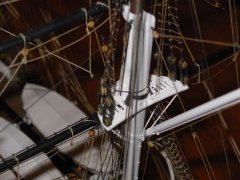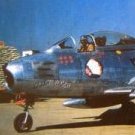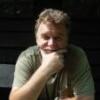-
Posts
596 -
Joined
-
Last visited
Reputation Activity
-
 Dziadeczek got a reaction from Dave_E in Rattlesnake by javajohn - Model Shipways - 1:64
Dziadeczek got a reaction from Dave_E in Rattlesnake by javajohn - Model Shipways - 1:64
Hi Javajohn ,
Since I built this model a long time ago, I don't remember now how long it took me to carve the transom. A few hours, at most. (I am a painfully slow modeler, I once knew a Japanese modeler, who would build three very intricate models in the time it took me to build one!)
Today I took a close up, macro pic of this transom. When I look at this pic, I think that it was rather a thin slice of boxwood I carved, instead of cherry - the color is more creamy/yellowish. The rest of the stern is cherry though.
I remember I made for this task a few tiny carving gouges, two from old discarded Dremel tips ground to the desired shape, and two or three from medical needles with their tips ground properly. You cannot buy such small gouges for this work anywhere, as far as I know!
Alltogether, this model is quite difficult and tricky to build, due to its small size. I remember they said that it was intended for an intermediate modeler, but I think that because of the size of tiny details and their delicate nature, it should be build by a more advanced modeler. One has to have a delicate touch and respect for the wood, plus very sharp tools...
PS: I just first noticed this glue blob oozing from the underneath of the lower left end of the transom; the pic is much larger than the model, so it exaggerates details and imperfections...
Happy modeling!
-
 Dziadeczek got a reaction from etubino in Rattlesnake by javajohn - Model Shipways - 1:64
Dziadeczek got a reaction from etubino in Rattlesnake by javajohn - Model Shipways - 1:64
I carved my own transom from a thin piece of wood (cherry, if I remember).
-
 Dziadeczek got a reaction from Canute in My metal ruler was wrong.
Dziadeczek got a reaction from Canute in My metal ruler was wrong.
Masa, you did not align both rulers precisely - hence you have this discrepancy. Go ahead and ALIGN them again. I have a feeling that everything will be OK, judging by your photographs.
-
 Dziadeczek reacted to Captain Slog in Borodino by Captain Slog - Dom Bumagi - 1:200 - CARD
Dziadeczek reacted to Captain Slog in Borodino by Captain Slog - Dom Bumagi - 1:200 - CARD
Hi All,
I previously made a post in the “Hull fittings” section of the forum on how I do the steps/ladders on the side of the hull, which you may have seen but I'll link below and expand on later as some lessons learned from that changed how I did the remainder.
New Content.
After doing the section covered above and in the video, I found I needed to change the method for consistently setting the gap for the step distance from the hull as my usual method was too clumsy due to step location and the shape of the hull.
After a bit of brain storming I came up with and made a ‘setting’ tool made from half round Evergreen styrene strip. I cut/scraped/sanded a recess into the end of one styrene strip. Then gluing another strip to it left a slot in the end big enough for the 0.2mm wire steps shown above.
I needed to scallop the styrene on both sides of the gap so it fitted between the closely placed steps. As the recess was made deeper than required I would install a step, ‘set it’ then sand the end of the tool back a bit and continue doing this until the correct depth of insertion was reached.
The process was then to insert all the steps roughly in place for a run of steps then use the ‘setting’ tool to push each step in to its final depth. When the tool touches the hull, it is at the correct depth of 0.5mm (gap). I would work down a section of steps before locking in place with glue.
Some photos of all 154 hull steps now fitted and glued in place. Using the ‘setting’ tool was very quick and got a more consistent finish from the method used in the video. I will paint them black once I install the horizontal hand rails that run along the sides of the hull.
Cheers
Slog
-
 Dziadeczek got a reaction from thibaultron in My metal ruler was wrong.
Dziadeczek got a reaction from thibaultron in My metal ruler was wrong.
Masa, you did not align both rulers precisely - hence you have this discrepancy. Go ahead and ALIGN them again. I have a feeling that everything will be OK, judging by your photographs.
-
 Dziadeczek got a reaction from mtaylor in My metal ruler was wrong.
Dziadeczek got a reaction from mtaylor in My metal ruler was wrong.
Masa, you did not align both rulers precisely - hence you have this discrepancy. Go ahead and ALIGN them again. I have a feeling that everything will be OK, judging by your photographs.
-
 Dziadeczek got a reaction from modeller_masa in My metal ruler was wrong.
Dziadeczek got a reaction from modeller_masa in My metal ruler was wrong.
Masa, you did not align both rulers precisely - hence you have this discrepancy. Go ahead and ALIGN them again. I have a feeling that everything will be OK, judging by your photographs.
-
 Dziadeczek got a reaction from AlleyCat in Mini lathe for mast making etc.
Dziadeczek got a reaction from AlleyCat in Mini lathe for mast making etc.
If the bed of your lathe is too short for your masts/spars, turn them in sections, drill holes on both ends (also on the lathe) and insert short pegs there and connect them (wood glue) together. If both pieces are the same thickness, you won't see the connection.
-
 Dziadeczek reacted to Ondras71 in Roter Löwe 1597 by Ondras71
Dziadeczek reacted to Ondras71 in Roter Löwe 1597 by Ondras71
Thank you so much Backer.. I thank everyone for the like..😇
Balcony railing glued..
During drying, I stuck a lion statue firmly..
..and began manufacturing the rudder..
Finished railing waxed, only a handrail..
-
 Dziadeczek got a reaction from mtaylor in Hairy/fuzzy rigging thread
Dziadeczek got a reaction from mtaylor in Hairy/fuzzy rigging thread
You have to do the burning off rather quickly, passing your thread over the flame, otherwise you run a risk of burning away the thread itself, especially polyester which melts in heat easily.
-
 Dziadeczek got a reaction from The Gimps Chimp in Hairy/fuzzy rigging thread
Dziadeczek got a reaction from The Gimps Chimp in Hairy/fuzzy rigging thread
You have to do the burning off rather quickly, passing your thread over the flame, otherwise you run a risk of burning away the thread itself, especially polyester which melts in heat easily.
-
 Dziadeczek got a reaction from Dave_E in Hairy/fuzzy rigging thread
Dziadeczek got a reaction from Dave_E in Hairy/fuzzy rigging thread
You have to do the burning off rather quickly, passing your thread over the flame, otherwise you run a risk of burning away the thread itself, especially polyester which melts in heat easily.
-
 Dziadeczek got a reaction from Gregory in Hairy/fuzzy rigging thread
Dziadeczek got a reaction from Gregory in Hairy/fuzzy rigging thread
You have to do the burning off rather quickly, passing your thread over the flame, otherwise you run a risk of burning away the thread itself, especially polyester which melts in heat easily.
-
 Dziadeczek got a reaction from Jolley Roger in Is there a Boudriot's 74 Gun Ship in "kit" form???
Dziadeczek got a reaction from Jolley Roger in Is there a Boudriot's 74 Gun Ship in "kit" form???
Hi Michael,
I am scratchbuilding this exact model in the same 1:48 scale, following the books by J. Boudriot.
It is a BIIIG puppy! If you want me to send you exact dimentions, I willl do it. Suffice it to say now, you would absolutely neccesarily need a separate space (a workshop of some kind) to build it. Kitchen table will not do it!!! And prepare yourself for YEARS of work!
If you want to build it exactly like the books describe it, it is a monumental task! But, it is doable, especially now that the addendum (all frame profiles and the keel) is available from Ancre. When I started to build it, this addendum was not available, so I had to hand draw all missing profiles, since Boudriot only shows the so called, station frames (every 4th). It took a long time to draw all of them by hand, since I did not own a computer program.
There is LOOOOTS of wood cutting, sanding and glueing, so several power tools are a must!
Right now I am approaching the running rigging stage and sewing sails from thin muslin. Here is a handful of randomly selected pics of this model.
Regards,
Thomas
-

-

-

-

-
 Dziadeczek got a reaction from Canute in Looking for a good "starter" pin vise set
Dziadeczek got a reaction from Canute in Looking for a good "starter" pin vise set
Greg,
It doesn't matter if the handle is made of aluminum or some kind of plastic, or similar. What matters is the material used for those jaws. It should be hardened steel, so it doesn't wear off quickly.
I just had a thought. What if I use a 3 jaw chuck from Dremel (it looks like it does have hardened steel jaws - I bought them for my self-made serving machine, to keep my ropes tightly apart while serving). It is easily obtainable from most hardware stores for little money. I just need to fashion a shaft for it from a piece of a brass rod . Drill the rod on one end to accommodate the length of a drill bit placed inside and cut a proper thread for the shaft to be able to screw on the Dremel chuck.
I checked it, by the way, - their chuck tightly holds # 80 drill bit! And everything else up to 3 mm thick.
If I want it, I can attach on the oposite end of this rod some sort of a spinning head, wooden ball or similar, to hold it comfortably in the palm of my hand.
By the way, the thread size for Dremel shaft is proprietary, but the size of a cutter M7 x 0.75 will work just as well.
-
 Dziadeczek got a reaction from Canute in Looking for a good "starter" pin vise set
Dziadeczek got a reaction from Canute in Looking for a good "starter" pin vise set
I too am looking for a new pin vise to replace my old "General" brand vise, which recently developed a round hole in the center of this 'cross' (see red arrow) and is unusable for the smallest drill bits. I resorted to attaching a separate pin holder to it, but this is only a temporary measure...
Greg, can you tell me, if your new vise can firmly hold a drill bit # 80?
I don't mind paying more for Starrett, but 90 (!) dollars is a bit stretch for my pocket... 😬
Also, I am looking for a vise that has these two double ended collets, with two different openings on their BOTH sides - for convenience's sake.
As far as I know, Starrett doesn't make such a vise; you have to buy two of their separate vises to accommodate drill bits from # 80 up to 3 mm thick.
120 bucks later...
-
 Dziadeczek got a reaction from mtaylor in Looking for a good "starter" pin vise set
Dziadeczek got a reaction from mtaylor in Looking for a good "starter" pin vise set
Greg,
It doesn't matter if the handle is made of aluminum or some kind of plastic, or similar. What matters is the material used for those jaws. It should be hardened steel, so it doesn't wear off quickly.
I just had a thought. What if I use a 3 jaw chuck from Dremel (it looks like it does have hardened steel jaws - I bought them for my self-made serving machine, to keep my ropes tightly apart while serving). It is easily obtainable from most hardware stores for little money. I just need to fashion a shaft for it from a piece of a brass rod . Drill the rod on one end to accommodate the length of a drill bit placed inside and cut a proper thread for the shaft to be able to screw on the Dremel chuck.
I checked it, by the way, - their chuck tightly holds # 80 drill bit! And everything else up to 3 mm thick.
If I want it, I can attach on the oposite end of this rod some sort of a spinning head, wooden ball or similar, to hold it comfortably in the palm of my hand.
By the way, the thread size for Dremel shaft is proprietary, but the size of a cutter M7 x 0.75 will work just as well.
-
 Dziadeczek got a reaction from mtaylor in Looking for a good "starter" pin vise set
Dziadeczek got a reaction from mtaylor in Looking for a good "starter" pin vise set
I too am looking for a new pin vise to replace my old "General" brand vise, which recently developed a round hole in the center of this 'cross' (see red arrow) and is unusable for the smallest drill bits. I resorted to attaching a separate pin holder to it, but this is only a temporary measure...
Greg, can you tell me, if your new vise can firmly hold a drill bit # 80?
I don't mind paying more for Starrett, but 90 (!) dollars is a bit stretch for my pocket... 😬
Also, I am looking for a vise that has these two double ended collets, with two different openings on their BOTH sides - for convenience's sake.
As far as I know, Starrett doesn't make such a vise; you have to buy two of their separate vises to accommodate drill bits from # 80 up to 3 mm thick.
120 bucks later...
-
 Dziadeczek got a reaction from thibaultron in Mini lathe for mast making etc.
Dziadeczek got a reaction from thibaultron in Mini lathe for mast making etc.
If the bed of your lathe is too short for your masts/spars, turn them in sections, drill holes on both ends (also on the lathe) and insert short pegs there and connect them (wood glue) together. If both pieces are the same thickness, you won't see the connection.
-
 Dziadeczek got a reaction from bruce d in Mini lathe for mast making etc.
Dziadeczek got a reaction from bruce d in Mini lathe for mast making etc.
If the bed of your lathe is too short for your masts/spars, turn them in sections, drill holes on both ends (also on the lathe) and insert short pegs there and connect them (wood glue) together. If both pieces are the same thickness, you won't see the connection.
-
 Dziadeczek got a reaction from EricWilliamMarshall in Anyone Know of a Book Detailing the Captains Cabin...
Dziadeczek got a reaction from EricWilliamMarshall in Anyone Know of a Book Detailing the Captains Cabin...
J. Boudriot in his "74 gun ship" details the cabins there, including the captain's cabin. Drawings and descriptions are given.













.thumb.jpeg.fc5d633a7b34428fcf19419a73d56d55.jpeg)